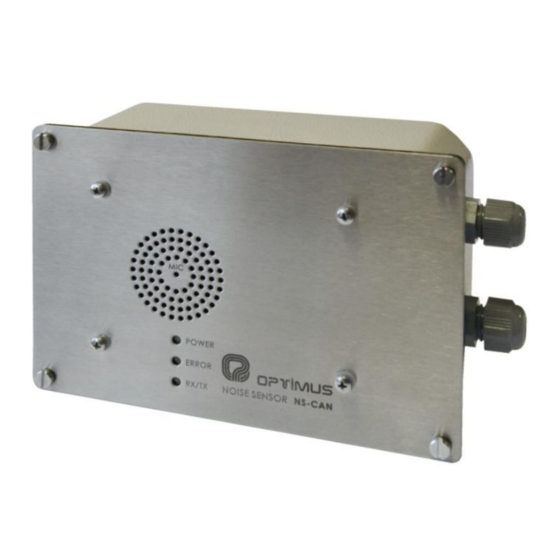Table of Contents
Advertisement
Available languages
Available languages
Quick Links
Advertisement
Chapters
Table of Contents

Summary of Contents for Opvimus NS-CAN
-
Page 3: Table Of Contents
PARTS OF THE EQUIPMENT..............................4 CAN BUS ADDRESS CONFIGURATION ............................. 5 CONNECTION..................................5 4.1. CAN Bus connection between NS-CAN and COMPACT unit ..................5 4.2. Connection between NS-CAN and COMPACT-E expansion unit ..................6 4.3. Power supply connection ............................. 7 4.4. -
Page 4: Features
Through a CAN bus it communicates with the COMPACT audio matrix unit sending the noise level measured in the particular loca- tion where it is placed. Each COMPACT matrix allows connecting up to 16 units of NS-CAN. 2. PARTS OF THE EQUIPMENT Figure 1. -
Page 5: Can Bus Address Configuration
CAN address. Values must be between 0 and 15. 4. CONNECTION ATTENTION: For the connection of the CAN bus it is recommended to use a shielded twisted pair AWG24 cable 4.1. CAN Bus connection between NS-CAN and COMPACT unit (Not connected) To COMPACT unit... -
Page 6: Connection Between Ns-Can And Compact-E Expansion Unit
NS-CAN Noise sensor for COMPACT SYSTEM 4.2. Connection between NS-CAN and COMPACT-E expansion unit The CAN communication speed of the NS-CAN is 33.3 To COMPACT or others kbit/s. For installation with COMPACT-E expansion COMPACT-E expansion units units with a communication speed of 500 kbit/s, a... -
Page 7: Power Supply Connection
ATTENTION: If you want to use an external microphone instead of the sensor's own microphone, you must change the NS-CAN configuration using the Call Point software by enabling this option. If an external microphone is used, the microphone integrated in the NS- CAN stops working. -
Page 8: Connection Between Several Ns-Can
1. Set the CAN address of the NS-CAN and its position in the BUS (end or intermediate element). 2. Make the connections between equipment. 3. Apply power to the units. 4. Via the Call Point software, configure the parameters of the NS-CAN and adjust the NS-CAN values for each zone. NS-CAN version 3.2.001... -
Page 9: Technical Specifications
CAN BUS. Communication speed: 33.3 kbits/s. Weight 0.5 Kg Cable entry 2 Cable gland PG-7 and 2 Blanking hole plugs (two PG-7 cable glands are also supplied). Front plate in INOX. Finishing Painted metal housing (RAL-7032). 7. DIMENSIONS NS-CAN version 3.2.001... -
Page 10: Software And Firmware Versions
R+D Department 4. Connection 3.2.000 October 2018 R+D Department 8. Software and firmware versions 3.2.001 February 2019 4.2. Connection between NS-CAN and COMPACT-E expansion unit R+D Department Approved By Function Date Ferran Gironès i Puig R+D Director 02/2019 NS-CAN version 3.2.001... -
Page 11: Guarantee
Amendments or corrections made to the details of the guarantee certificate Tel.+34 972203300 – Fax.+34 972218413 or purchase invoice. e-mail: export@optimus.es 1999/44/CE • Failure to produce the original invoice or the absence of a date on this. NS-CAN version 3.2.001... - Page 14 CONEXIÓN ..................................... 5 4.1. Conexión del sensor de ruido NS-CAN a la matriz COMPACT ..................5 4.2. Conexión del sensor de ruido NS-CAN a la unidad esclava COMPACT-E ............... 6 4.3. Alimentación del sensor de ruido ..........................7 4.4. Conexión de un micrófono externo ..........................7 4.5.
-
Page 15: Características
Mide el nivel de ruido del lugar donde está ubicado, enviando los datos obtenidos a la matriz de audio COMPACT a través de un bus CAN. Cada matriz COMPACT permite la conexión de hasta 16 unidades NS-CAN. 2. ELEMENTOS Figura 1.Vista frontal Figura 2. -
Page 16: Configuración De La Dirección Can
0 y 15. 4. CONEXIÓN ATENCIÓN: Para la conexión del bus CAN se recomienda la utilización de un cable de par trenzado y apantallado AWG24. 4.1. Conexión del sensor de ruido NS-CAN a la matriz COMPACT (No conectado) A la matriz COMPACT Fuente de alimentación 24VCC... -
Page 17: Conexión Del Sensor De Ruido Ns-Can A La Unidad Esclava Compact-E
NS-CAN Sensor de ruido para sistemas COMPACT 4.2. Conexión del sensor de ruido NS-CAN a la unidad esclava COMPACT-E La velocidad de comunicación CAN del NS-CAN es de A la matriz COMPACT u otras 33,3 kbit/s. En instalaciones con unidades esclavas unidades esclavas COMPACT-E COMPACT-E, cuya velocidad de comunicación es de... -
Page 18: Alimentación Del Sensor De Ruido
Si desea utilizar un micrófono externo en lugar del micrófono del propio sensor, debe cambiar la configuración del NS-CAN me- diante el software Call Point y habilitar esta opción. Al utilizar un micrófono externo, el micrófono integrado en el NS-CAN deja de funcionar. -
Page 19: Conexión Entre Ns-Can
5. PUESTA EN MARCHA DEL EQUIPO La puesta en marcha del NS-CAN requiere el envío de configuraciones a la matriz de audio COMPACT de cuyo bus CAN depende el sensor de ruido. Para ello, es necesario un PC equipado con tarjeta de red y conectado a la matriz COMPACT, bien a través de un switch Ethernet, o directamente a través de un cable de red. -
Page 20: Características Técnicas
CAN BUS. Velocidad de comunicación: 33,3 kbits/s. Peso 0,5 Kg 2 Prensaestopas PG-7 y 2 tapas ciegas (se suministran además dos prensaestopas PG-7 acce- Entradas de cable sorios). Placa frontal en acero inoxidable. Acabados Caja en hierro pintado gris RAL-7032 7. MEDIDAS NS-CAN versión 3.2.001... -
Page 21: Versiones De Software Y Firmware
Mayo 2017 6. Características técnicas R+D Department 4. Conexión. 3.2.000 Octubre 2018 R+D Department 8. Versiones de software y firmware. 4.2. Conexión del sensor de ruido NS-CAN a la unidad esclava 3.2.001 Febrero 2019 R+D Department COMPACT-E Approved By Function Date Ferran Gironès i Puig... -
Page 22: Condiciones De Garantía
Tel. 902 151 96 / 972 203 300 • Enmiendas o tachaduras en los datos del certificado de garantía o factura Fax. 972 21 84 13 de compra. e-mail:girona@optimus.es 1999/44/CE • Falta de factura original o falta de fecha en la misma. NS-CAN versión 3.2.001...

Need help?
Do you have a question about the NS-CAN and is the answer not in the manual?
Questions and answers